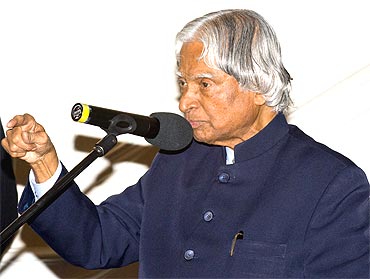
Former president Dr A P J Abdul Kalam, visiting Washington, DC, did what he does best and likes the most in recent years -- engaging with students. Listening in rapt attention is rediff.com's Aziz Haniffa.
Though it was an affair with students, Kalam used the occasion to convey the message to the powers that be in the US that their reluctance to utilize the core competence of India in science and technology was to their detriment and cited the example of the joint ventures between Indian and Russian scientists in the development of such systems such as the supersonic BrahMos cruise missile system with an initial investment of $150 million which was now bringing in revenue to the tune of over $7 billion.
For over an hour, more than 200 students and faculty at George Washington University, listened with rapt attention as Kalam, fresh from a teaching stint at the University of Kentucky's Gatton College of Business and Economics, articulated both his World Vision 2030 and his vision for India's future, which he has laid out in his recent book India 2020, and exhorted the international community to make use of India's core competence in science and technology to enrich both India and the world's societies.
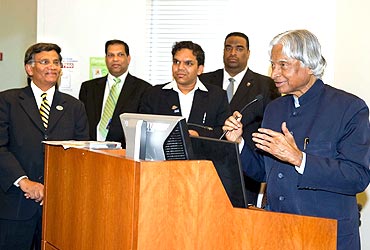
At the outset, he laid forth a question to the audience, saying that "India and China may become economically developed nations in a decade and the G-8 may thus become G-10. But I am asking, would this select group of economically developed nations bring global prosperity, peace and happy societies to the world?"
Then, in answering his own rhetorical question, argued, "The sustained prosperity of India, the US or any other nation cannot evolve in isolation with the rest of the world. In a globalized world, our problems are shared, our efforts are shared, and the prosperity and the happiness will hence be shared across the nations and societies as well."
He said his World Vision 2030, envisages "a world where core competencies of each nation are identified, missions synergizing the core competence of different nations lead to economic advantage and faster development for all the societies."
"A world of nations where all the students of all the societies are imparted education with value systems," he said, and noted to peals of laughter, "Every nation has a value system and that value system starts before age 17. Afterwards nothing can be done."
Kalam said it would be "a world of nations where the governance is responsive, transparent and corruption free. A world of nations with creative leadership who ensure the effective mechanism to resolve conflicts between nations and societies in a timely manner keeping overall peace and prosperity of the world as a goal."
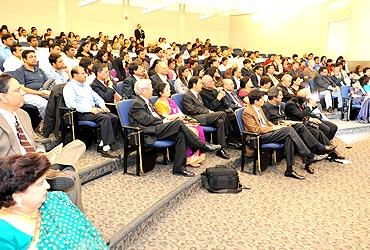
The erstwhile president said the foot-soldiers of this multi-pronged, multi-dimensional approach would be "the youth of the world who are ready to contribute to this development," and what was needed to make this happen was "to enable them with a global cadre of skill-sets and higher education skills."
A major part of realizing this vision was he said "borderless technology connecting people, connecting minds, connecting ideologies," and he explained how India was using this kind of connectivity "based on its core competence to evolve a world class product system using innovation, creativity and knowledge generation and knowledge sharing and knowledge dissemination among the scientists."

He said that one such in this decade "is the design, development and production of a supersonic cruise missile BrahMos by and Indo-Russian joint venture. BrahmMos is the first supersonic operational cruise missile in the world which can be launched from multiple platforms and it has the maneuvering and capability against different types of targets, whether on sea, on land or any other type of warfare."
"Most importantly, an advanced world-class system has been realised in the shortest possible time leapfrogging other countries. This is indeed the result of technological and financial cooperation leading to an operational system," he said, and added: "This successful design, development and production of BrahMos missile through the innovative way of technology cooperation between India and Russia with an investment of $150 million has led to a business of $7 billion."
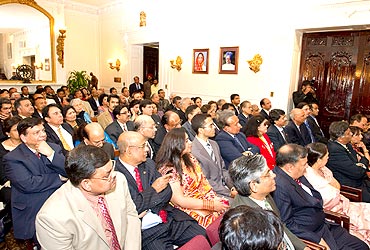
Thus, Kalam declared that this example showed that "the connectivity and sharing of core competence will lead to the evolution of global knowledge, capital sharing platform in the form of a world knowledge platform."
On April 21, Sivathanu Pillai, head of BrahMos Aerospace, announced in Kuala Lumpur at the Defense Services Asia 2010 Exhibition that the Indian Air Force would arm 40 Russian-built Sukhoi fighter jets with BrahMos missiles.
The BrahMos missile has a range of 290 km and can carry a warhead of up to 300 kg and can effectively engage ground targets from an altitude as low as 10 metres and has a top speech of Mach 2.8, which is said to be 10 times faster than the US-made Tomahawk missile.
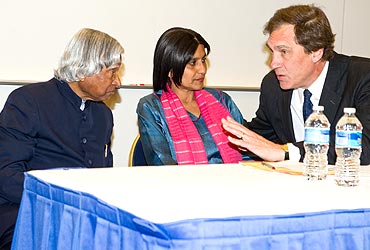
Deepa Ollapally, Associate Director of The Sigur Center for Asian Studies at GWU, in a rousing introduction of Kalam, said, "He is a larger-than-life figure," and "he's left an indelible mark in India's scientific community, and is known as India's missile man."
"But that would be too narrow to call him just that," she said. "He has been right at the center of every major scientific and defense development in India since he began his career."